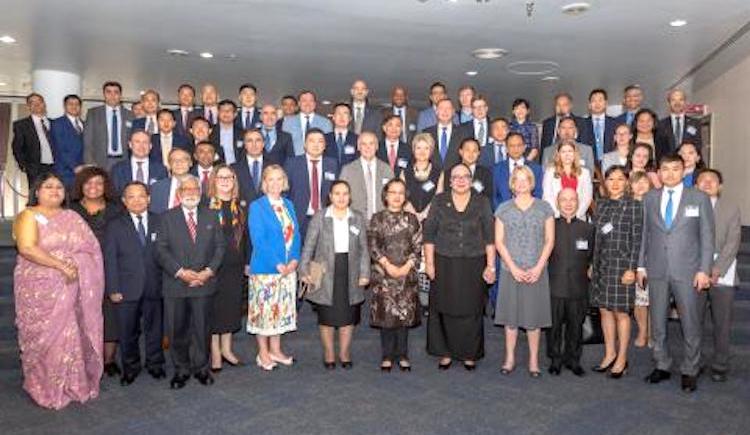
By Santo D. Banerjee
NEW YORK | BANGKOK (IDN) – Lack of territorial access to the sea, isolation and remoteness from world markets impose constraints on trade competitiveness of the 32 landlocked developing countries (LLDCs) and their overall socio-economic development.
In addition to the geographical impediments, LLDCs face challenges linked to high trade and transport costs, limited or low-quality infrastructure, delays at borders, bottlenecks related to customs procedures and border crossing regulations, and productivity constraints.
They cannot also fully tap into the benefits of trade such as investment, finance, technology and services needed to further improve productive capacity in agriculture, industry and services sectors that are needed for structural transformation of their economies.
To address the challenges of the LLDCs, the international community adopted in 2014 the Vienna Programme of Action (VPoA) for Landlocked Developing Countries for the Decade 2014-2024.
Nearing the halfway in the implementation of the VPoA, the LLDCs exhibit mixed results in their progress in achieving the priorities of the Vienna Programme. The real growth in gross domestic product for the LLDCs declined to 2.8% in 2016, down from 5.6% in 2014.
The LLDCs continue to account for less than one percent of the global merchandise trade and the exports remain undiversified and comprise mainly of primary commodities. Despite the continued efforts to expand and upgrade the transport infrastructure, inadequate quality and deficiencies in the physical infrastructure remain.
Access to electricity in the LLDCs has increased but remains below the world average and costs of ICT services in the LLDCs remain high. While most LLDCs have ratified the WTO Trade Facilitation Agreement – entailing the simplification, modernization and harmonization of export and import processes – their implementation of the Agreement lags behind.
The LLDCs have become more active participants in regional trade agreements and economic blocks, bringing positive prospects for their further integration into regional trade. On structural economic transformation, there has been limited progress as demonstrated by the relatively low value-added contribution of the manufacturing sector in the LLDCs.
Means of implementation, in particular ODA and FDI flows to LLDCs remain important sources of financing for the LLDCs, however, remain concentrated in just a handful of LLDCs and are insufficient to fully address the needs of the LLDCs.
Against this backdrop, the UN Economic and Social Commission for Asia and the Pacific (UNESCAP), the UN Economic Commission for Europe (UNECE) and the UN Office of the High Representative for Least Developed Countries, Landlocked Developing Countries and Small Island Developing States (UN-OHRLLS) organized the Euro-Asian Regional Midterm Review of the implementation of the VPoA on February 11-12 in Bangkok, Thailand.
Senior government officials and experts from LLDCs, transit developing countries and development partners, concluded the meeting on February 12, in which they identified and shared best practices and innovative approaches to accelerate the implementation of the VPoA and adopted an outcome document highlighting recommendations to overcome the challenges faced by the Euro-Asian LLDCs.
The Euro-Asian LLDCs are: Afghanistan, Armenia, Azerbaijan, Bhutan, Kazakhstan, Kyrgyzstan, Lao PDR, the Republic of Moldova, Mongolia, Nepal, Tajikistan, Turkmenistan, the Former Yugoslav Republic of Macedonia and Uzbekistan.
“While the trade area has made progress in terms of agreements signed, it is the ratification of other relevant international conventions by both LLDCs and the transit countries that has been relatively low over the review period,” said the High-Representative and Under-Secretary-General for OHRLLS, Fekita ‘Utoikamanu.
“To illustrate the challenge: in terms of international trade, the LLDCs continue to account for less than 1% of global merchandise trade. Exports remain concentrated around a few commodities, with low value addition and low technology content. This is troubling but above all it is cause for ACTION. We must work to reduce the high trade costs. Overcoming this obstacle remains fundamental to integrating LLDCs into global trade,” she added.
An outcome document emerging from the meeting highlights the importance of strengthening regional and sub-regional cooperation on fundamental transit policies and accession to key international legal instruments; upgrading and maintaining existing road, rail, and information and communications technology (ICT) networks with the support of development partners, multilateral financial and development institutions, regional banks and organizations such as ESCAP, ECE, UN-OHRLLS and ITU.
“Many LLDCs in the region have strengthened their efforts to support the soft infrastructure required to facilitate trade – and attract the investment, finance, technology and services needed to improve productive capacity. All these efforts should contribute to strengthening LLDCs’ connectivity and integration into the region’s economy,” said United Nations Under-Secretary-General and Executive Secretary of ESCAP, Armida Salsiah Alisjahbana.
“However, there remains great potential to deepen this integration by harmonizing policies to improve transit connectivity and support the creation of regional markets,” she emphasized.
The implementation of the VPoA constitutes an integral part of the implementation of the 2030 Agenda for Sustainable Development and the commitment of the international community engrained in this Agenda is to leave no one behind, including LLDCs.
In this context, transport is of particular importance for landlocked developing countries, emphasized UNECE Executive Secretary Olga Algayerova. “At UNECE we work closely with LLDCs in the Euro-Asian region to support their integration into the global economy, through practical tools such as the TIR Convention – enabling the reduction of cross-border transport time for goods by up to 80% and costs by up to 38% – and projects to strengthen Euro-Asian transport connectivity, which have helped prioritize over 300 infrastructure investment initiatives”, she said.
The meeting, which is the first out of the three regional meetings scheduled to take place in the lead up to the upcoming Midterm Review in December, brought together senior government officials, the Euro-Asian LLDCs, as well as representatives of transit countries from the region and development partners. [IDN-InDepthNews – 12 February 2019]
Photo: Euro-Asian Regional Midterm Review participants. Credit: UNESCAP
IDN is flagship agency of the International Press Syndicate.
facebook.com/IDN.GoingDeeper – twitter.com/InDepthNews











